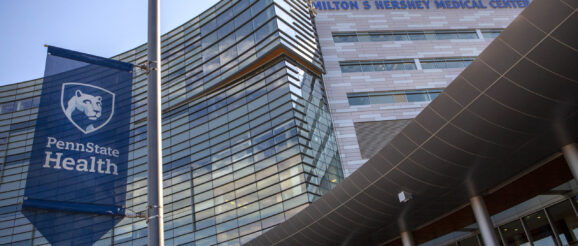Leading local response to a pandemic, growth of virtual care and clinical innovation shaped 2019-2020 fiscal year

Berini shares Milton S. Hershey Medical Center’s fiscal year highlights during annual public board meeting
An unprecedented pandemic. Learning how to live with COVID-19. Participating in groundbreaking clinical trials. Continued growth to serve the region. Deborah Berini, president of Penn State Health Milton S. Hershey Medical Center, talked about these hallmarks of a unique year during the hospital’s annual public Board of Directors meeting today.
Many of the details Berini shared highlight how the Milton S. Hershey Medical Center and Penn State College of Medicine led Penn State Health’s response to the COVID-19 pandemic, from quickly overhauling hospital operations in preparation to treat an unknown, highly infectious disease, to evolving to continue to treat patients with the virus, as well as all other patients who need care.
“Without question, this has been one of the most challenging years in recent history for healthcare professionals,” Berini said. “Our faculty and staff stepped willingly into unknown territory. Not only did they provide exceptional clinical care, but they went above and beyond to provide our patients with the most thoughtful, compassionate care. It’s the people who work here, and their commitment to the communities we serve, that make this organization so strong.”
Martha Jansen, a nurse in one of Hershey Medical Center’s COVID-19 units, innovating a phone system to limit time in patient rooms but maintain critical personal connect and support, and Dr. Susan Borys helping to launch a relief effort for patients with food insecurity are just two examples of the many ways staff went above and beyond to ensure patients were getting the care they need—both in the hospital and in their homes.
Hershey Medical center is always striving to improve the quality and safety of its care. Fiscal year 2020 again demonstrated high overall outcomes and patient satisfaction, as well as national recognitions, including:
Clinical advancements remained key focus for Hershey Medical Center and the College of Medicine during fiscal year 2020. Faculty, staff and students strive to discover and employ cutting-edge technology, groundbreaking treatments and product development. Examples of these clinical advancements include:
Ongoing construction projects on the Hershey campus and within the health system are moving forward to meet the demand for the advanced, high-quality care that Hershey Medical Center provides. The Children’s Hospital expansion project, on track to open in November, will add more pediatric beds for enhanced access to nationally-ranked care in the central Pennsylvania region. It will feature state-of-the-art technology, a new Women and Babies Center, a 56-bed, Level IV neonatal intensive care unit (NICU) and the state’s only Small Baby Unit, created specifically for growth and improved brain development. The expansion of the Emergency Department at Hershey Medical Center continues; a new ambulance entrance provides advanced patient privacy.
During fiscal year 2020, clinical activity remained strong amid the COVID-19 outbreak. Outpatient visits totaled more than 1 million, and the Medical Center performed more than 30,000 surgeries. Overall admissions decreased slightly from fiscal year 2019 at 26,900.
Medical Center and College of Medicine researchers earned more than $102 million in external research funding in fiscal year 2020, an increase from more than $98 million in 2019. This money supports faculty and staff in scientific studies into the causes, treatments, cures and prevention of disease. Examples of the research supported by these dollars include:
Virtual access to Hershey Medical Center’s primary and specialty care grew exponentially during fiscal year 2020. The system’s virtual visit app, Penn State Health OnDemand, provided nearly 7,000 free virtual COVID-19 screenings, along with nearly 3,500 virtual urgent care visits and 41,000 virtual visits.
